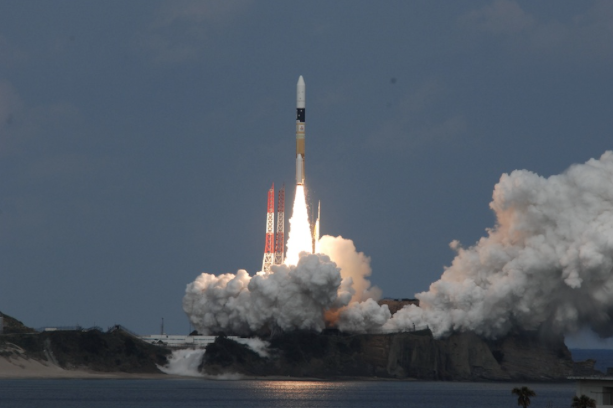[SatNews] The Hayabusa mission launched in 2003 and returned to Earth in 2010 with a sample from a small asteroid near Earth named “25143 Itokawa”.
Moog Inc. (NYSE: MOG.A and MOG.B) Space and Defense Group provided critical hardware to the Hayabusa-2 satellite and H-IIA rocket that launched on December 3 at 1:22:04 p.m. (JST) from Tanegashima, Japan. The launch vehicle and spacecraft RCS Thrusters were built by Mitsubishi Heavy Industries, Ltd. (MHI). The Electric Propulsion (EP) System was built by MHI and NEC Corporation (NEC), and the spacecraft was built by NEC in Japan. The Hayabusa-2 mission is JAXA’s follow-on to Hayabusa to perform a robotic sample return from an asteroid and bring it back to Earth. The Hayabusa mission launched in 2003 and returned to Earth in 2010 with a sample from a small asteroid near Earth named “25143 Itokawa”.

Japan’s Hayabusa 2 asteroid mission blasts off from Tanegashima Space Center aboard an H-2A rocket. Credit: JAX
MHI’s H-IIA rocket includes the first stage gimbal actuator assembly with servovalves built in Moog’s Hiratsuka, Japan facility. This facility also provides roll control thruster valves for the Epsilon rocket that is based upon solid rocket technology found on the H-IIA.
NEC’s Hayabusa-2 bus includes both chemical and electric propulsion. Moog supplies 24 thruster valves to control the flow of propellant to each of the 12 MHI rocket engines and two bipropellant torque-motor latch valves to provide isolation of bipropellants. For the spacecraft’s electric propulsion, two solenoid latching valves maintain isolation of xenon and six electronic pressure regulation valves contribute pressure and flow regulation of xenon to the electric thrusters.
In addition to propulsion components, Moog also provided spacecraft mechanisms to the satellite bus. A thruster gimbal assembly enables ion thruster vector pointing and attitude control for four ion engines. The Asteroid Multi-band Imaging Camera (AMICA) on Hayabusa 2 contains a Moog filter wheel with eight positions mounted at the end of the telescope to cover different bands, seven of which are compatible with the Eight Color Asteroid Survey (ECAS). Finally, two types of high gain antenna pointing assemblies allow for the gimbaling of the antenna for communication from the spacecraft back to Earth. Learn more about Moog here.
The Hayabusa-2 mission will build upon the legacy of the original Hayabusa spacecraft. Moog provided the same components and subsystems to MHI for the original Hayabusa mission. The proven performance of Moog’s contribution to the mission will assist in JAXA’s goal to strengthen Hayabusa-2.
Hayabusa-2 is expected to arrive at the target asteroid “(162173) 1999 JU3” in July 2018 and perform a survey for a year and a half before returning to Earth in December 2020.

